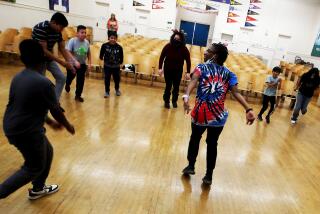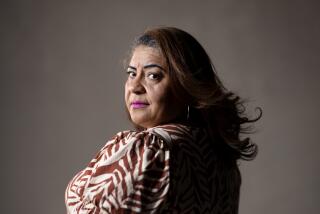Acrimony, Unsolved Issues Remain After Teachers Strike
The Los Angeles teachers strike that for nine days paralyzed the nation’s second-largest school district was sustained by the same venomous feelings that fuel any family argument.
“We both wanted to make up, but each side felt it was the other’s fault,” said Los Angeles school board member Jackie Goldberg. “The feeling was, ‘It’ll be a cold day in hell before I make the first move.’ ”
United Teachers-Los Angeles President Wayne Johnson recalled: “In a war a lot of things are said and sometimes after it is over, you think maybe it was an intemperate remark. At the time, I think those things had to be said. And if I had to do it over, I would do it again.”
The battle over power and pay sent more than 20,000 teachers to the picket lines and virtually shut down the district’s 600 schools. It also became a duel of personalities and passions that finally exploded into a near fistfight at last Sunday’s negotiating session.
That ugly incident and subsequent accusations of lying on both sides prompted the state Democratic Senate and Assembly members from the Los Angeles area to beckon district and union officials to Sacramento two days later. The legislators, playing the role of kindly-but-firm parents, called for apologies and then persuaded both sides to return to the bargaining table, with assurances that an enormous state tax surplus would make a settlement easier.
Bigger Questions
A day later, the strike was settled.
But as more is learned of how the strike ended, bigger questions emerge: why the walkout couldn’t have been avoided in the first place and what the settlement will mean for education in the Los Angeles Unified School District.
“It sounds like the conflict was bought off, which will last for the short run, indeed maybe for years,” said UC Berkeley education professor James Guthrie. “But it can’t solve the long-term problems, and it is not clear how many of these changes will make education better for students.”
Each side accuses the other of seeking a strike for its own gain.
Some district sources speculate that leaders of United Teachers-Los Angeles believed a strike necessary to release the anger and frustration built up among teachers, fanned in part by months of Johnson’s increasingly harsh rhetoric.
“After a year of such bitter acrimony, the feeling was that a strike would be cathartic,” said one district source.
UTLA’s Johnson says that some district officials welcomed a walkout, hoping that a low turnout on the picket line would reduce the union’s influence.
“The more I look back on it, it seemed all very carefully orchestrated,” Johnson said.
The union chief said he expected 15,000 teachers to walk out and was stunned to learn that 23,000 struck that first day. He said his bargaining position was strengthened because those numbers never dipped very far below 20,000.
Using substitute teachers and administrators, the district held to its promise to keep schools open even if the curriculum was limited to showing cartoons and movies. And the district was encouraged by the slowly increasing numbers of students and teachers returning to the classroom.
Even now, as both sides lick their wounds and calculate their losses, there is no clear winner.
Teachers gained a 24% pay raise over three years, about 2.5% more than the district had offered before the strike began.
Salary Loss
But striking teachers lost about 4.5% of their annual salary for being out of work nine days.
The strike also cost the union treasury about $750,000 for everything from picket signs to the rental of the Sports Arena, where teachers voted Thursday to end the walkout.
Still, many teachers say that more important than the money are guarantees of greater say in running schools, a symbol of respect denied them in the past.
According to district officials, the new contract will cost about $700 million over three years and require at least $120 million in cuts in school programs over two years.
But the district held off union demands to restore all the pay docked for job actions, as well as efforts to gain majority control over school governing councils of teachers, administrators and parents that will be created under the contract. The district also resisted demands to allow the union to automatically collect fees from the 10,000 teachers who are not UTLA members.
The district, however, paid a high price in the chaos on campuses during the strike. And it may find some working relationships poisoned for years to come.
Education experts outside the district said the settlement may help students if the higher salaries attract good teachers.
Problem Not Addressed
But according to UCLA economics professor Werner Hirsch, who has studied the district, the contract ignores one thorny problem: how to keep experienced teachers at tougher, inner-city schools. Hirsch, who once helped author a proposal to break the district up into smaller units, suggests further increasing compensation for teachers who decide to stay at schools in rough neighborhoods.
Lewis Solmon, dean of UCLA’s Graduate School of Education, said he is pleased about the higher salaries in the contract but cautioned: “To the extent that the higher salaries keep good teachers in the system and attract new competent teachers, that’s good. But if it keeps the bad ones in, that’s unfortunate.”
Also under debate are the new school councils, which will make decisions over class scheduling, student discipline and the spending of some funds.
According to Solmon, there is no evidence that teachers and parents will be better able than trained administrators to make essentially administrative decisions. “I’m not sure if it will improve anything except that it will probably make teachers feel better about their work and turn them on to their jobs more.”
Bureaucracy Remains
UC Berkeley’s Guthrie, who also co-directs Policy Analysis for California Education, an influential education research group, said the settlement appears to have done little to solve another major problem: changing the stifling, bureaucratic nature of large school districts. He had hoped that the councils would have some say on teacher hiring and tenure, but that did not come to be.
The strike also could affect the composition of the seven-member Board of Education. Board member Julie Korenstein, who has received much of her support from the teachers union, faces challenger Gerald Horowitz in a runoff election June 6. Alan Gershman faces a union-backed challenger, Mark Slavkin, in the same election. The main question for the runoff is whether anti-union sentiment will hurt Korenstein’s and Slavkin’s chances.
The strike also put a spotlight on the political divisions on the board.
Three board members--Gershman, Rita Walters and Leticia Quezada--had publicly opposed the district’s offer even before the strike began because of the cuts needed to pay for it. Those board members appeared to have little role in the negotiations. Board members Korenstein, Warren Furutani and Jackie Goldberg favored giving teachers the raise.
That left board President Roberta Weintraub as the swing vote on the most controversial issues.
For example, Weintraub entered the negotiating session last Sunday hopeful for a quick settlement because she was finally prepared, sources said, to support teacher pay raises of 24% over three years, regardless of the size of the state surplus. Previously, the board had offered a solid 21.5%, with the possibility of another 2.5% if enough new state monies arrived.
What happened next is disputed.
Stormed Out of Meeting
Union leaders, who already were steamed because they were left waiting five hours before the session got under way, claim that the money offer was never formally made. They say that they were so angered by what they said was district back-stepping on non-monetary issues that they exploded in anger and stormed out.
“I probably have never been as out of control with anger as I was that night,” recalled UTLA Vice President Helen Bernstein. “Multiply that by Wayne.”
District officials insist the money offer was made. “There clearly was a misunderstanding,” district negotiator Dick Fisher said.
Suddenly, it appeared that the strike might last several more weeks, possibly until the end of the spring semester.
But the following morning Assemblywoman Maxine Waters (D-Los Angeles) telephoned Johnson and Weintraub, inviting them and other key players to the Sacramento meeting on Tuesday.
“The big risk in going into this is you can either be helpful or exacerbate the problem,” Waters recalled. The two sides, she said, didn’t want to be in the same room at the statehouse but “then I apologized for wanting to take them a step forward.” She said the antagonists left for home with “only dangling issues” unresolved.
At 3 p.m. Wednesday, the bargaining teams returned to the Westin Bonaventure Hotel for what turned out to be a 10-hour marathon. The result was a contract with compromises from both the district and the union, as well as hints of struggle ahead.
“There are going to be some people who are happy with it and some people who are not,” Weintraub said of the settlement. “You can’t win. You can only ensure you go forward.”
The UTLA, according to its leaders, will push for the school councils to gain more power and for teachers to get more preparation time, among other goals, in the next contract.
After all, union Vice President Bernstein reminded, “we begin to negotiate again in 13 months.”
More to Read
Sign up for Essential California
The most important California stories and recommendations in your inbox every morning.
You may occasionally receive promotional content from the Los Angeles Times.











